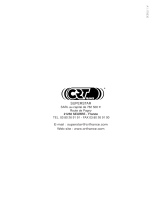
SUPPLIED ACCESSORIES/OPTIONAL ACCESSORIES .................. 1
PREPARATION .................................................................................... 2
Mobile Installation ............................................................................ 2
DC Power Cable Connection........................................................... 3
Mobile Operation .......................................................................... 3
Fixed Station Operation ................................................................ 4
Replacing Fuses ........................................................................... 4
Antenna Connection ........................................................................ 5
Accessories Connections ................................................................ 6
External Speaker .......................................................................... 6
Microphone ................................................................................... 6
PC Connection ............................................................................. 6
GETTING ACQUAINTED ..................................................................... 7
Front Panel ...................................................................................... 7
Rear Panel....................................................................................... 8
Microphone ...................................................................................... 8
WORKING MODE ................................................................................ 9
OPERATING BASICS .........................................................................10
Switching The Power On/Off ..........................................................10
Adjusting The Volume .....................................................................10
Switching The Working Mode .........................................................10
Selector Knob Adjusting Frequency/Channel .................................10
Squelch Off / Squelch Off Momentary ............................................10
Receiving ........................................................................................10
Transmitting .................................................................................... 11
Transmitting Tone-Pulse .................................................................11
Transmitting Optional Signaling ......................................................11
SHORTCUT OPERATIONS ................................................................12
Channel Edit ...................................................................................12
Channel Copy .................................................................................12
Channel Delete ..............................................................................12
Channel Name Edit .......................................................................13
Short Call ........................................................................................13
Frequency/Channel Scan ...............................................................13
CTCSS/DCS Scan..........................................................................13
Priority Monitor ...............................................................................14
High/Mid/Low Power Switch (Shortcut) ..........................................14
Offset Direction Setup (Shortcut) ....................................................14
Wide/Narrow Band Setup (Shortcut) ..............................................15
Compander Function (Shortcut) ....................................................15
Reverse Function (Shortcut)...........................................................15
Pre-stored DTMF Code Searching and Transmitting .....................15
Scan Channel Skip .........................................................................16
CHANNEL OPERATIONS .................................................................17
CTCSS/DCS Encode Setup ...........................................................17
CTCSS/DCS Decode Setup ...........................................................17
Add Or Cancel DTMF/2-Tone/5-Tone Signaling .............................17
Choose To Transmit 2-Tone ............................................................18
Choose To Transmit 5-Tone ...........................................................18
Signaling Combination Setup .........................................................19
Offset Direction Setup ....................................................................19
Offset Frequency Setup ..................................................................20
Frequency Step Size Setup ............................................................20
Wide/Narrow Band Setup ...............................................................20
Frequency Reverse Setup ..............................................................20
CONTENTS




















